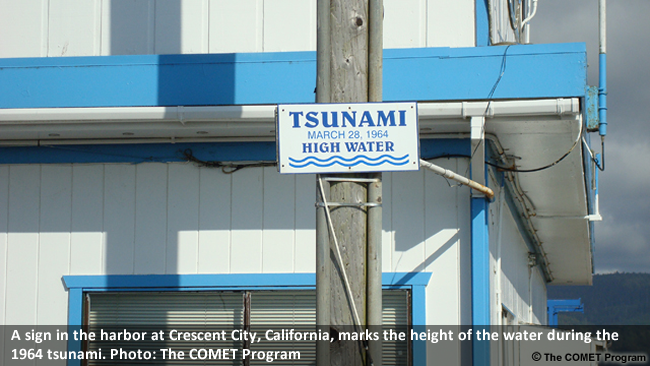
A tsunami is one the most powerful and destructive natural forces. It is a series of waves (not just one) caused by a large and sudden displacement of the ocean. Tsunamis radiate outward in all directions from the disturbance and can move across entire ocean basins. Most tsunamis are caused by large earthquakes below or near the ocean floor, but tsunamis can also be caused by landslides, volcanic activity, certain types of weather and near earth objects (e.g., asteroids, comets). Not all earthquakes cause tsunamis.
Not all tsunamis act the same. And, an individual tsunami may impact coasts differently. A small tsunami in one place may be very large a few miles away.
The speed of a tsunami depends on the depth of the ocean. In the deep ocean, tsunamis are barely noticeable but can move as fast as a jet plane, over 500 mph. As the waves enter shallow water near land, they slow to approximately 20 or 30 mph. That is still faster than a person can run.
As the waves slow down, they can grow in height and currents intensify. Most tsunamis are less than 10 feet high, but in extreme cases, can exceed 100 feet. When a tsunami comes ashore, it will not look like a normal wind wave. It may look like a fast-rising flood or a wall of water. Sometimes, before the water rushes on land, it will drain away suddenly, showing the ocean floor, reefs and fish like a very low, low tide. Tsunamis can travel up rivers and streams that lead to the ocean. A large tsunami can flood low-lying coastal areas more than a mile inland.
The series of waves that flood, drain away and then reflood the land may last for hours. The time between waves ranges from five minutes to two hours. The first wave to reach the shore may not be the largest or the most damaging. It is not possible to predict how long a tsunami will last, how many waves there will be, or how much time there will be between waves.
A tsunami can be very dangerous to coastal life and property. It can produce unusually strong currents, rapidly flood land and cause great destruction. The flow and force of the water and the debris it carries can destroy boats, vehicles, and buildings and other structures; cause injuries; and take lives as the tsunami moves across the land. It only takes six inches of fast-moving water to knock over an adult and two feet of fast-moving water to carry away most vehicles. The water can be just as threatening (if not more so) as it returns to the sea, taking debris and people with it. Flooding and dangerous currents can last for days.
Even small tsunamis can pose a risk. Strong currents can injure and drown swimmers and damage and destroy boats in harbors. And be aware, a tsunami is not surfable. Tsunamis are not like wind waves. They do not have a face, do not curl and break like wind waves and are full of hazardous debris.
To learn more about the tsunamis, read the Tsunami Frequently Asked Questions.